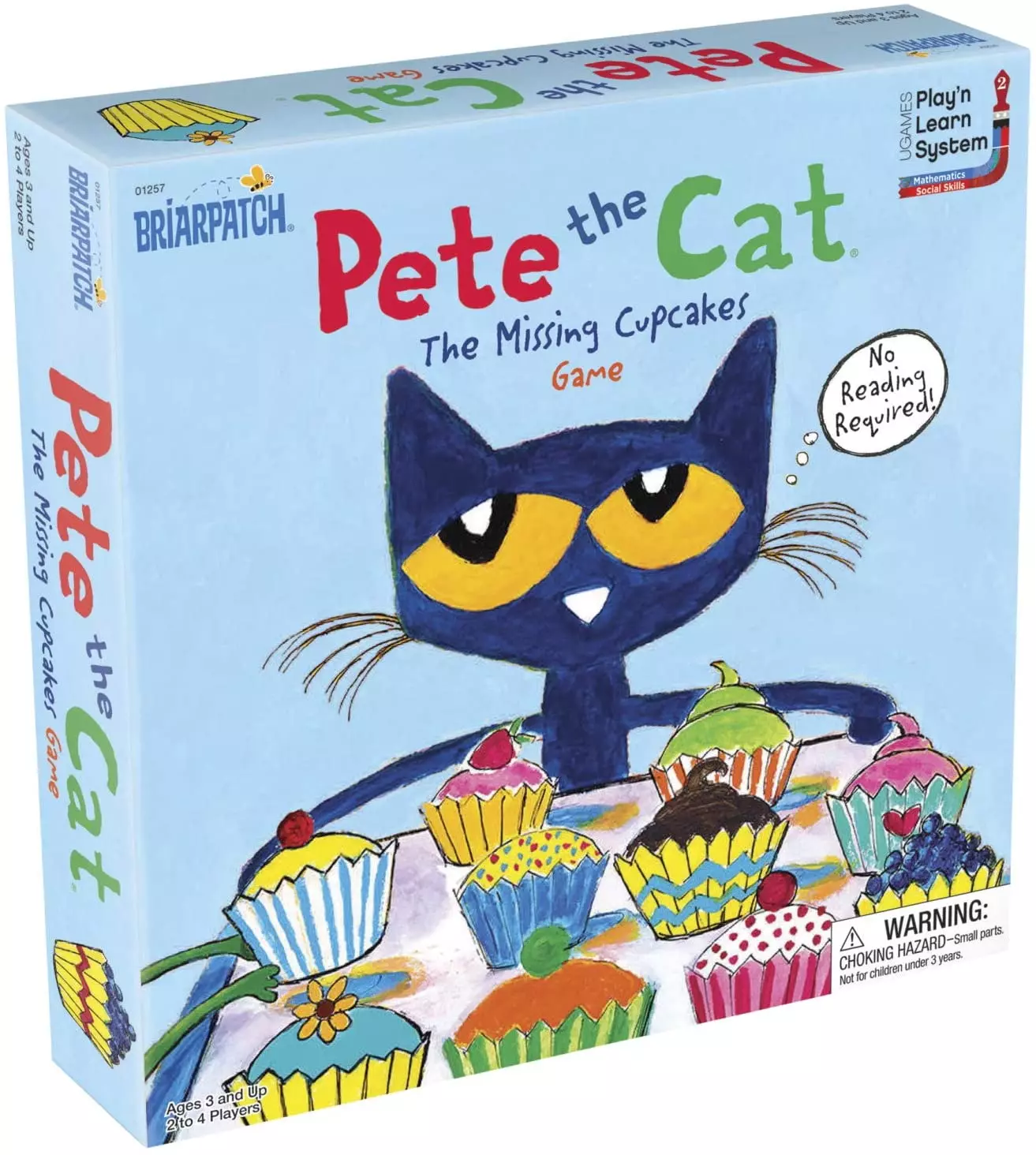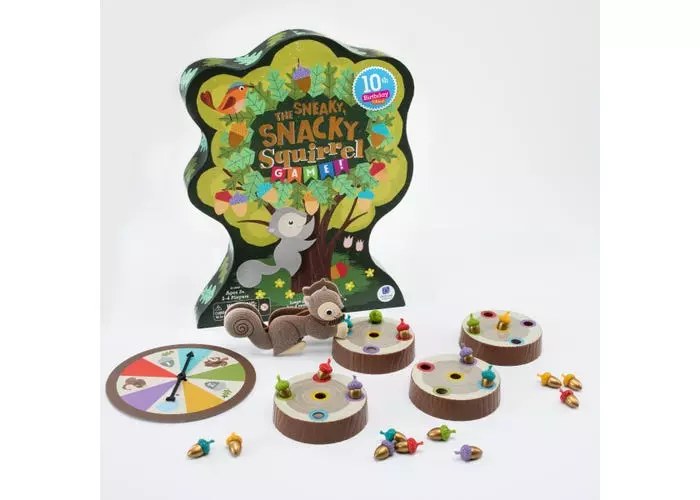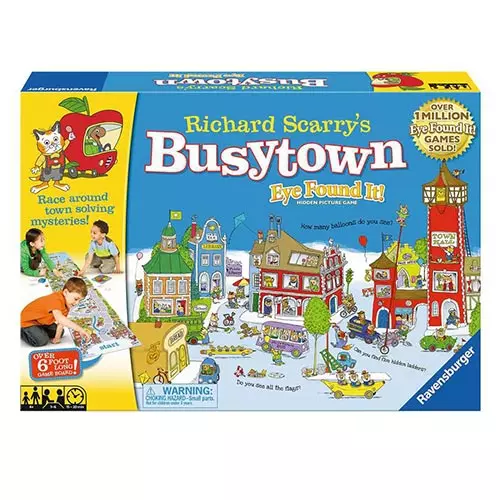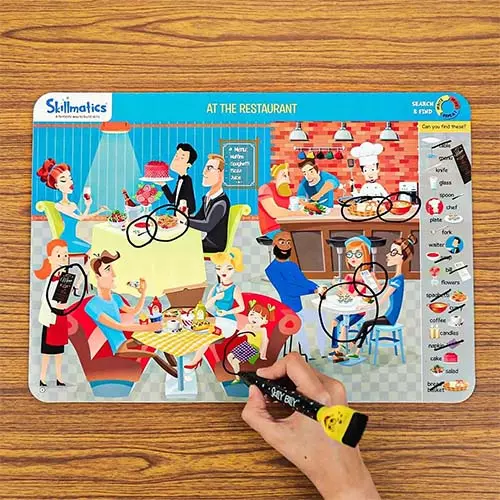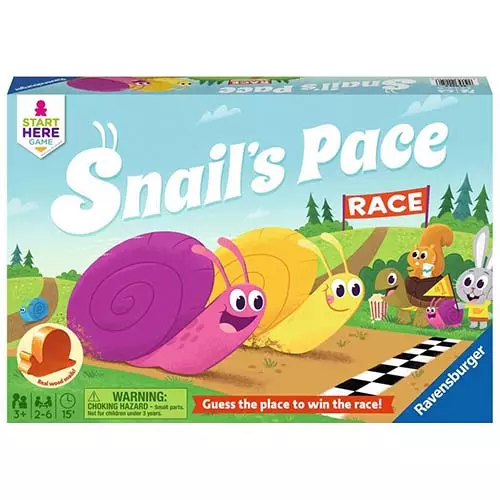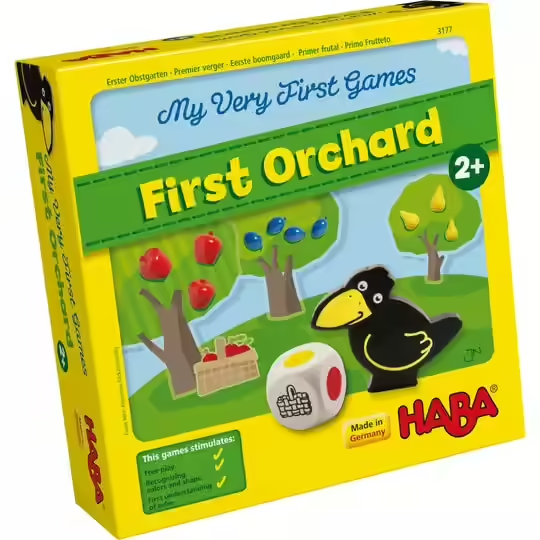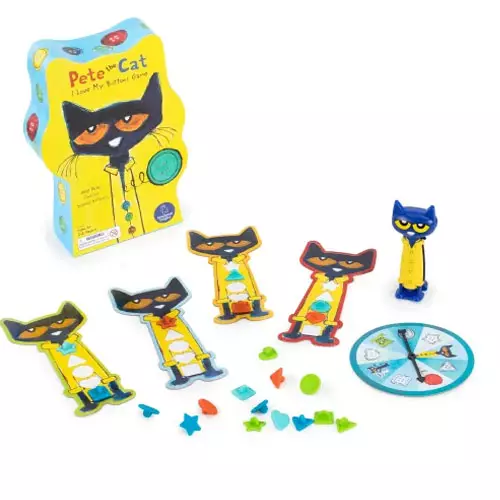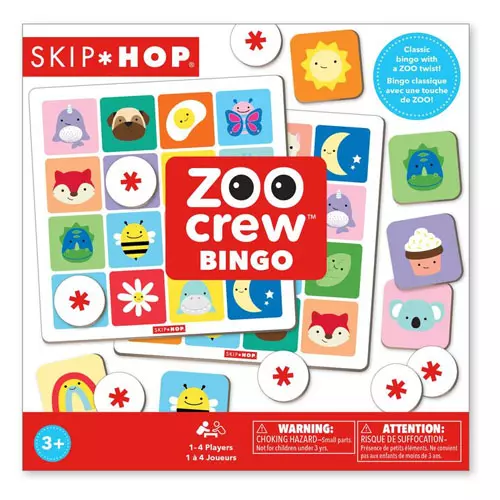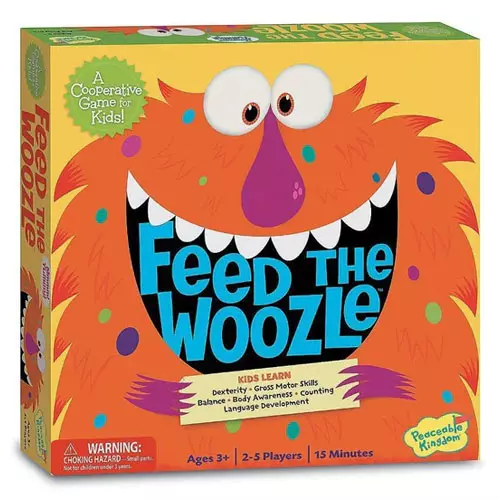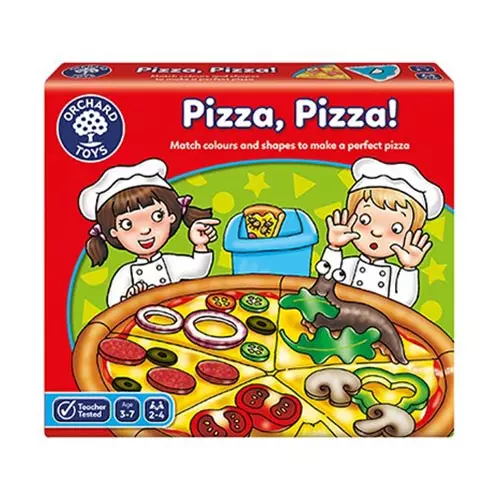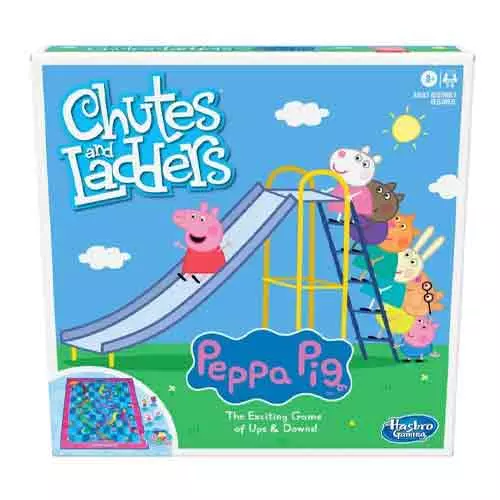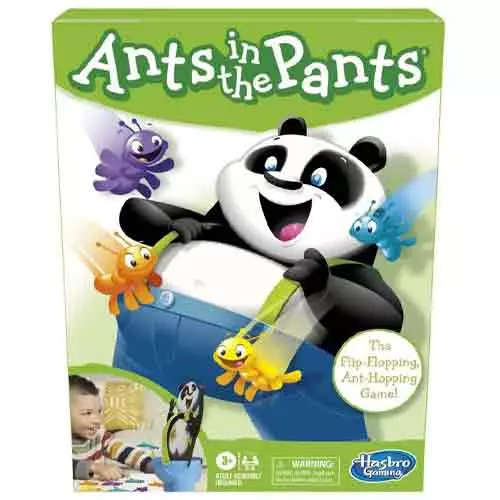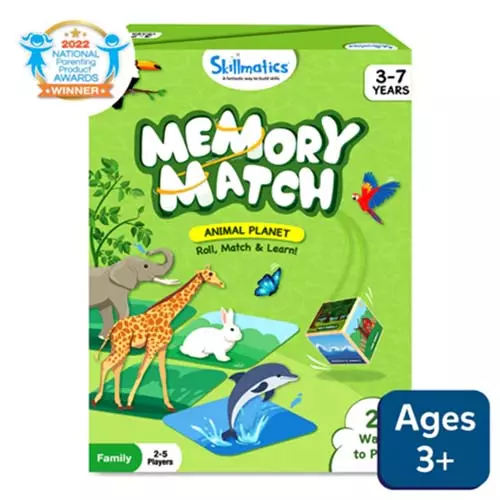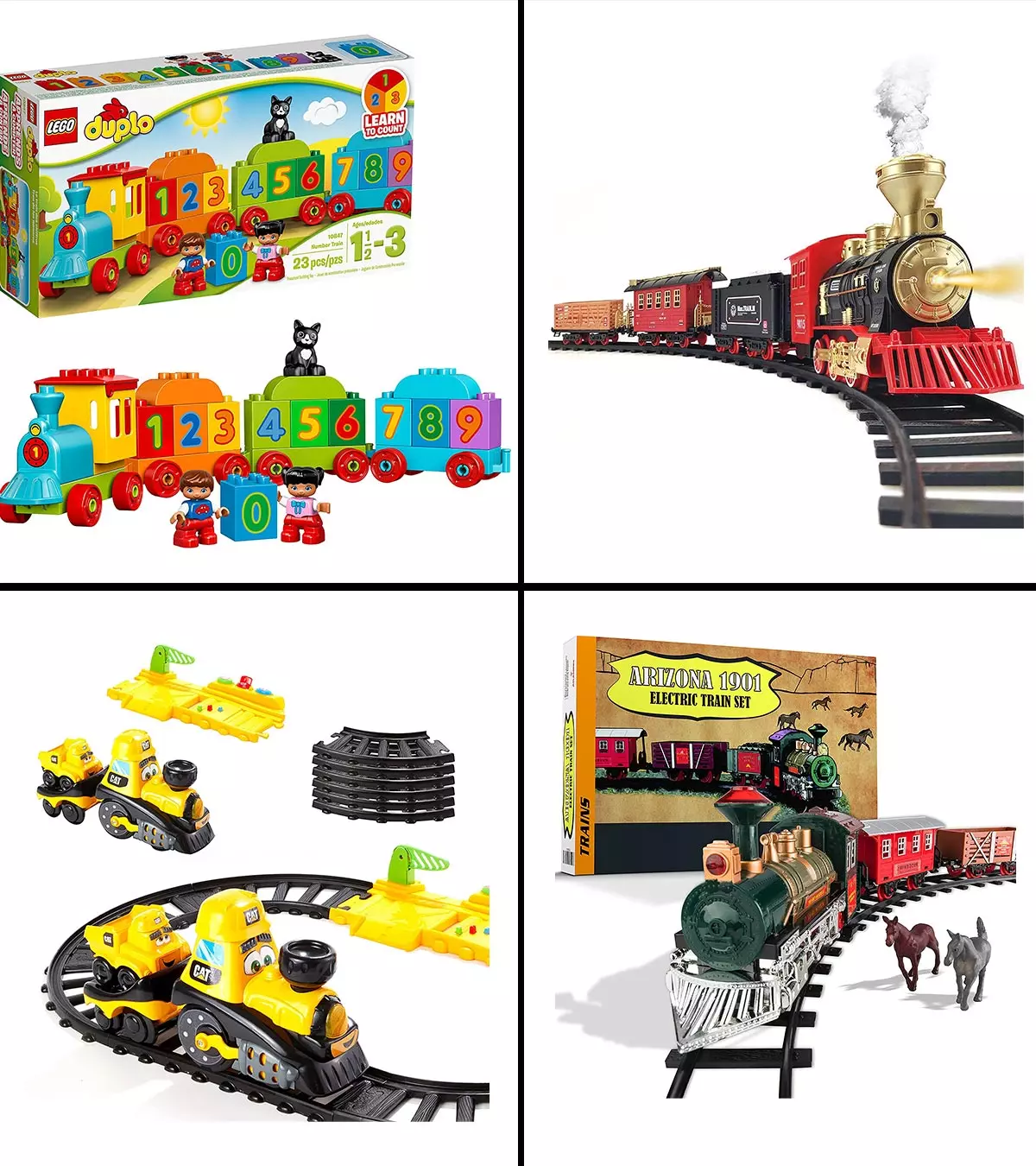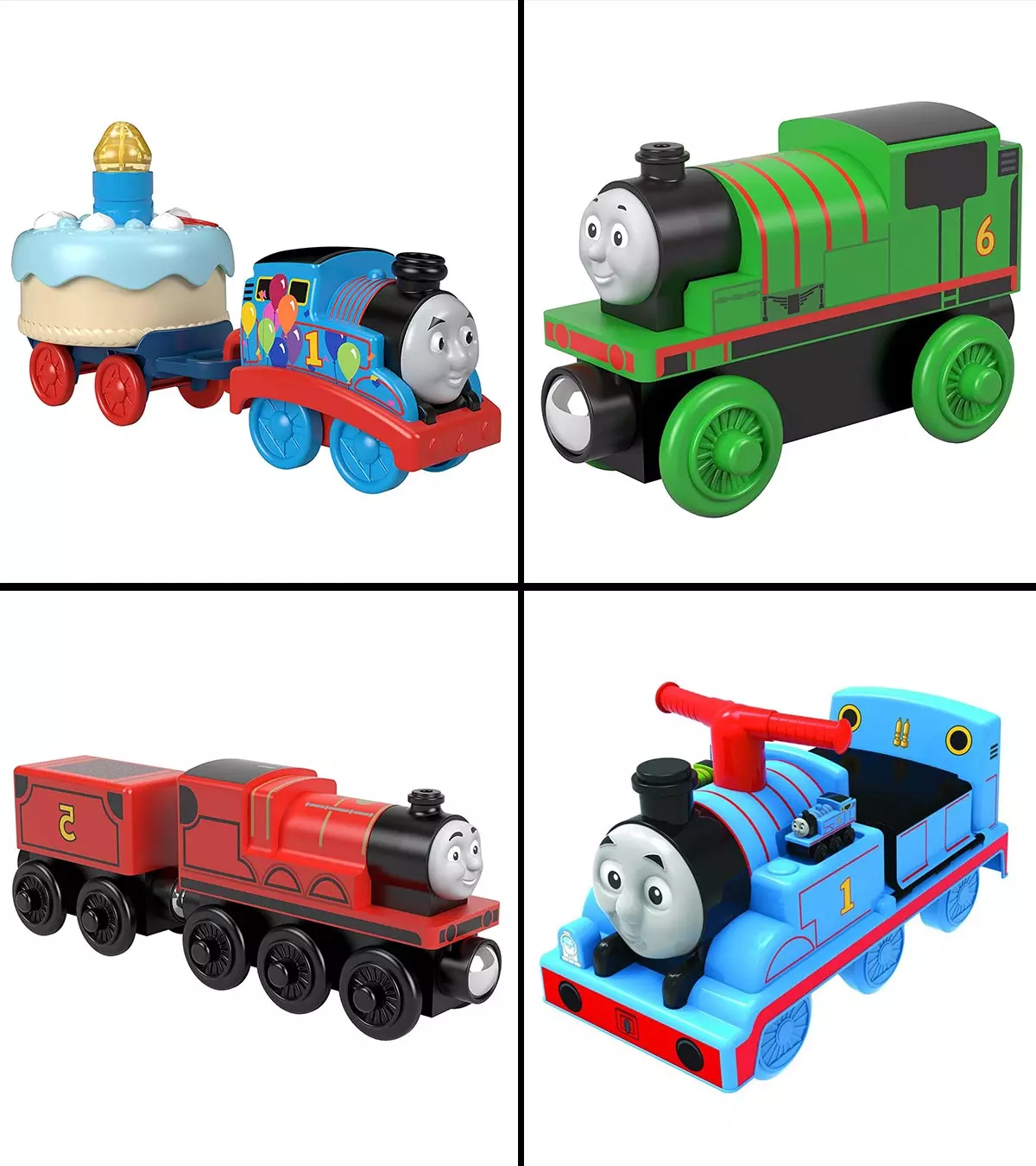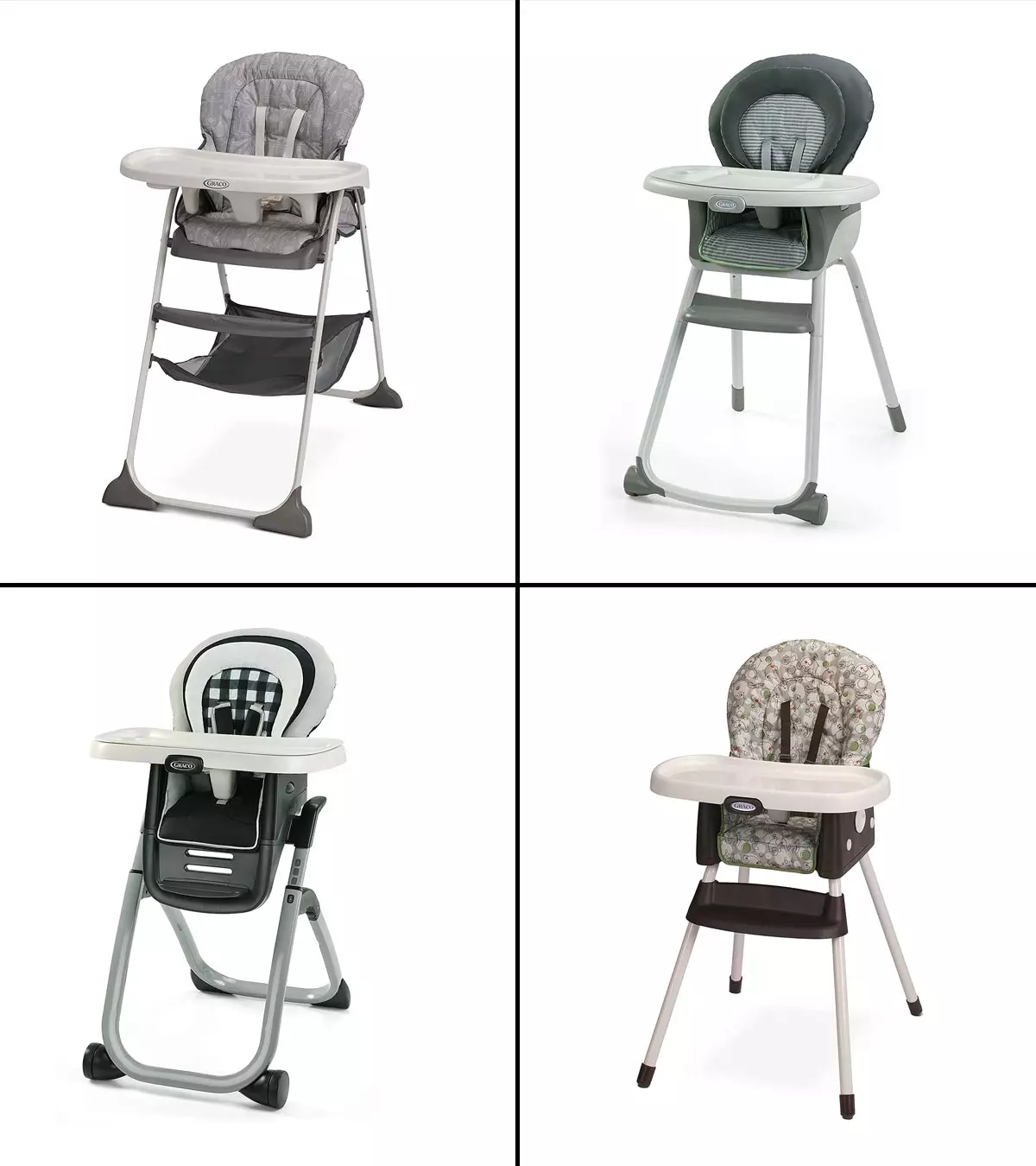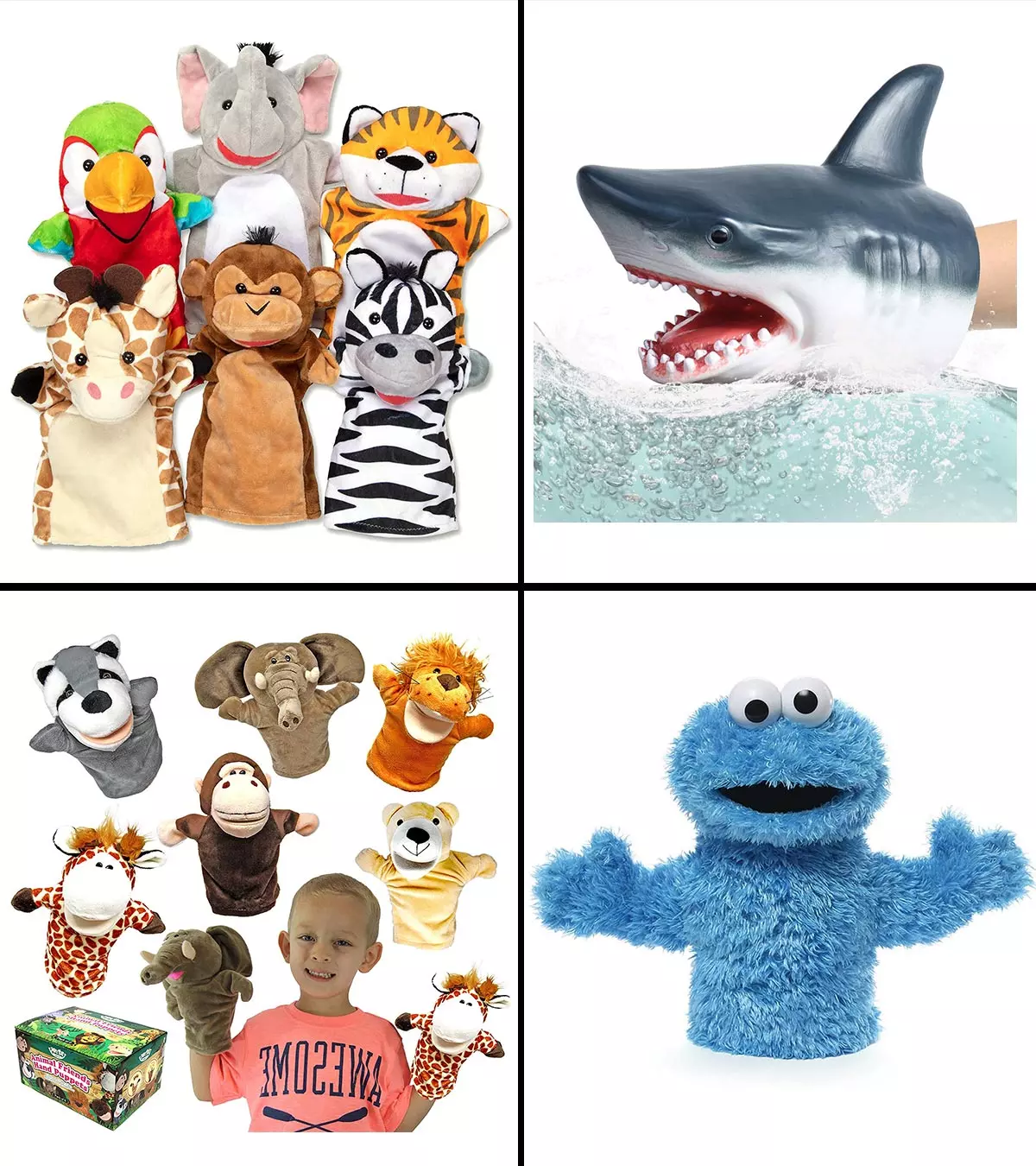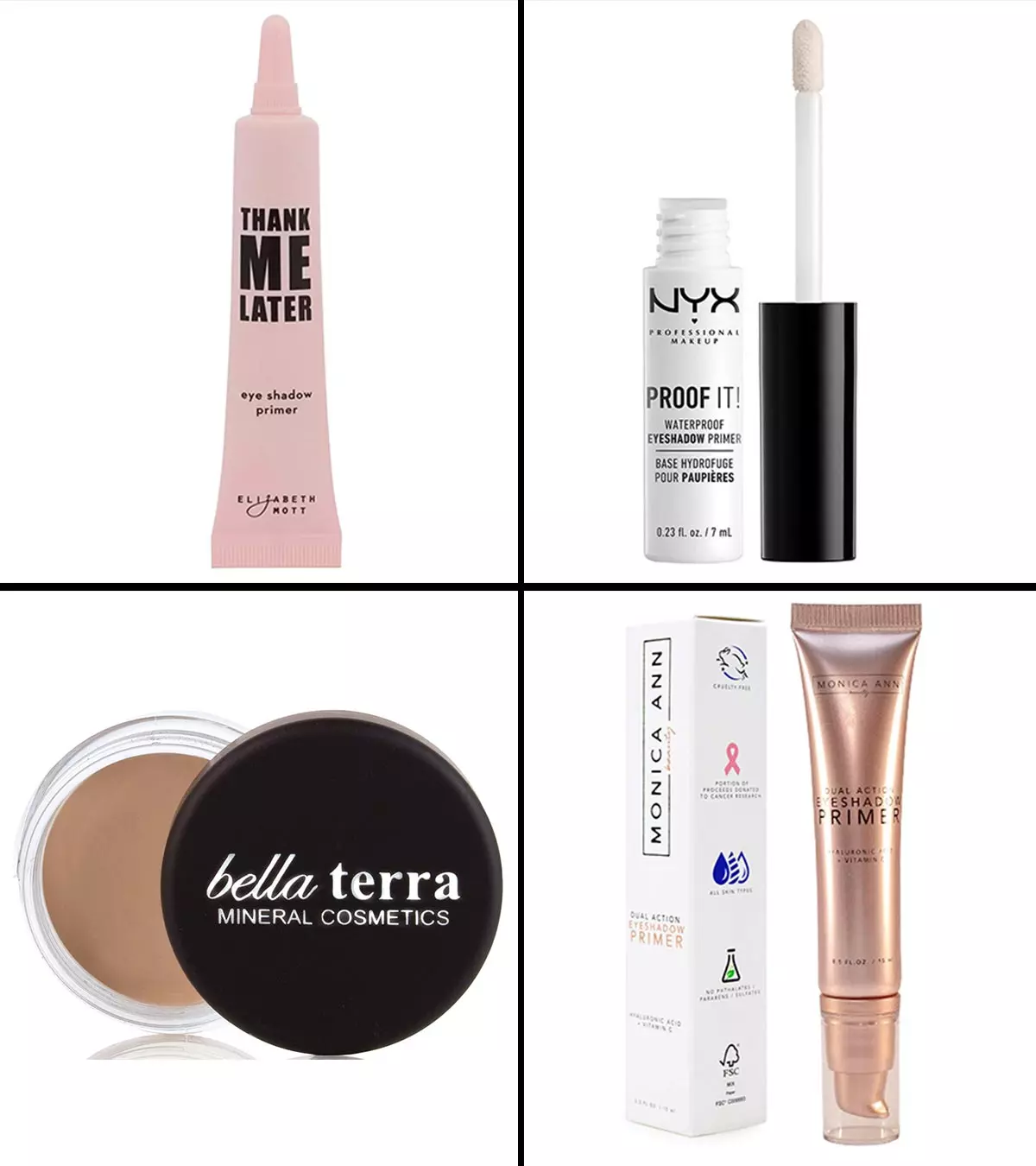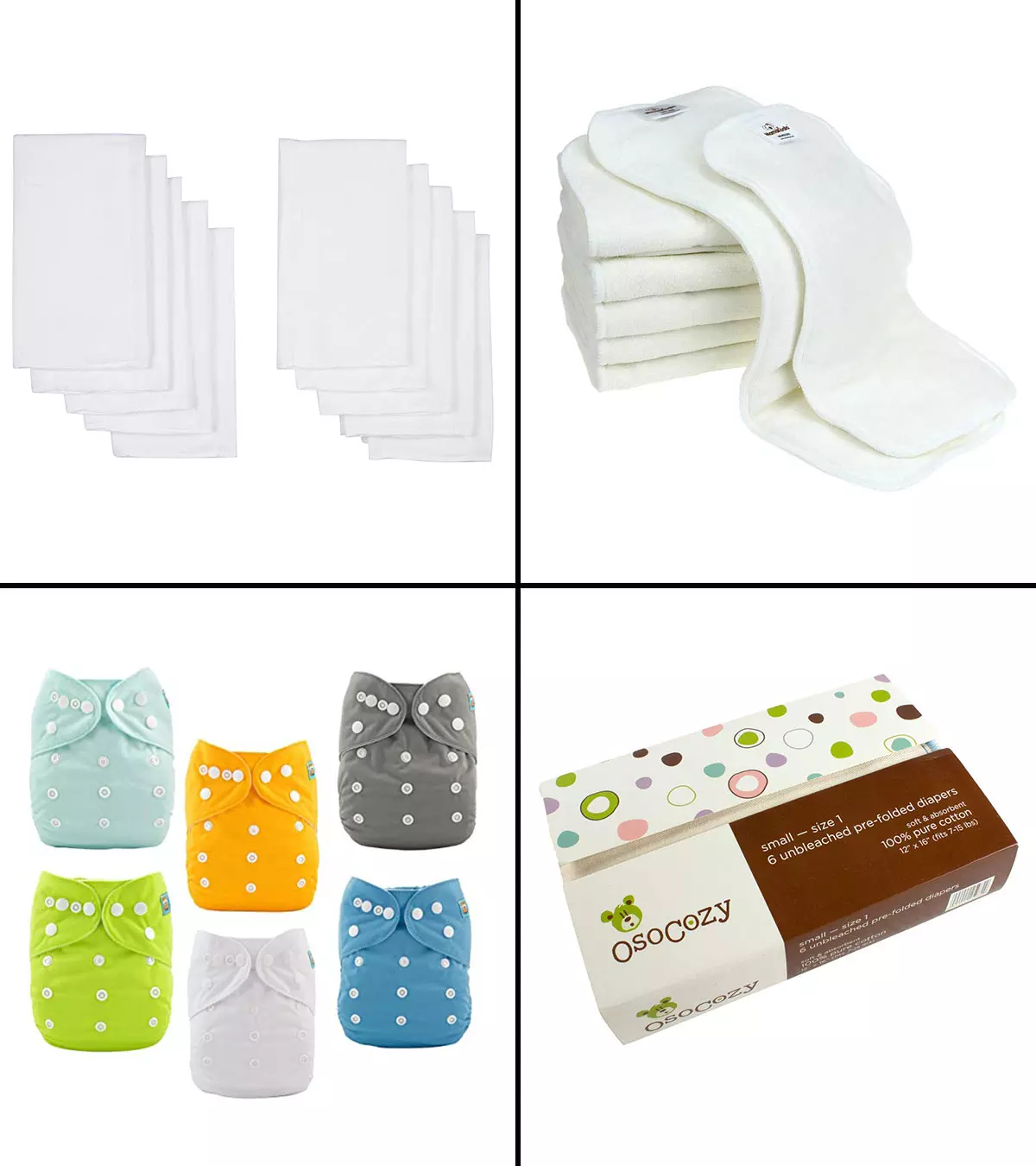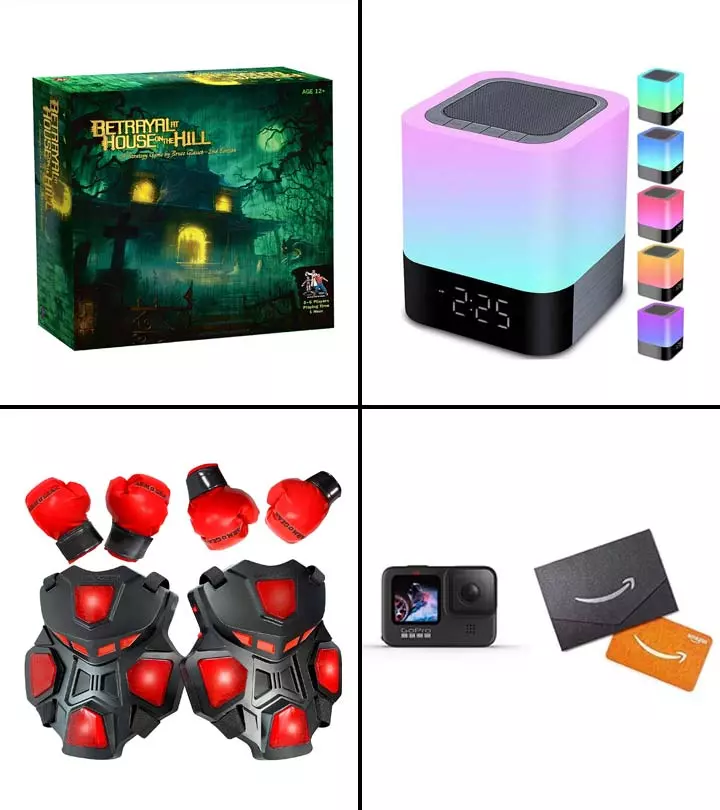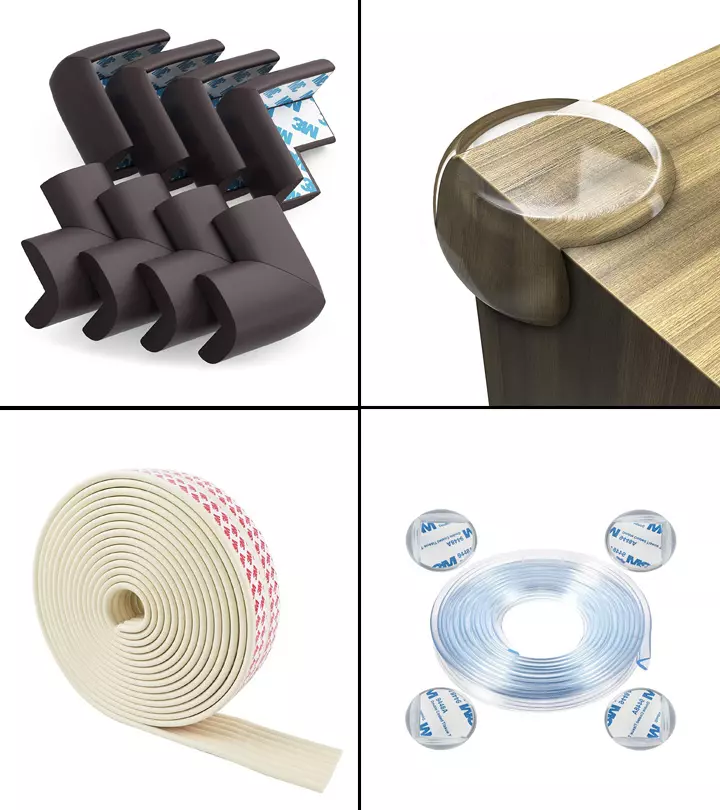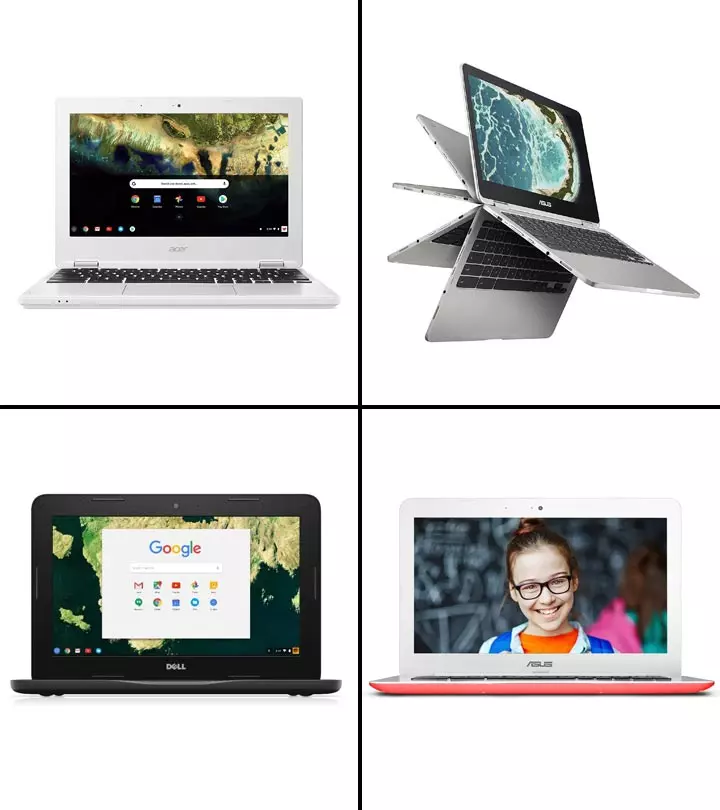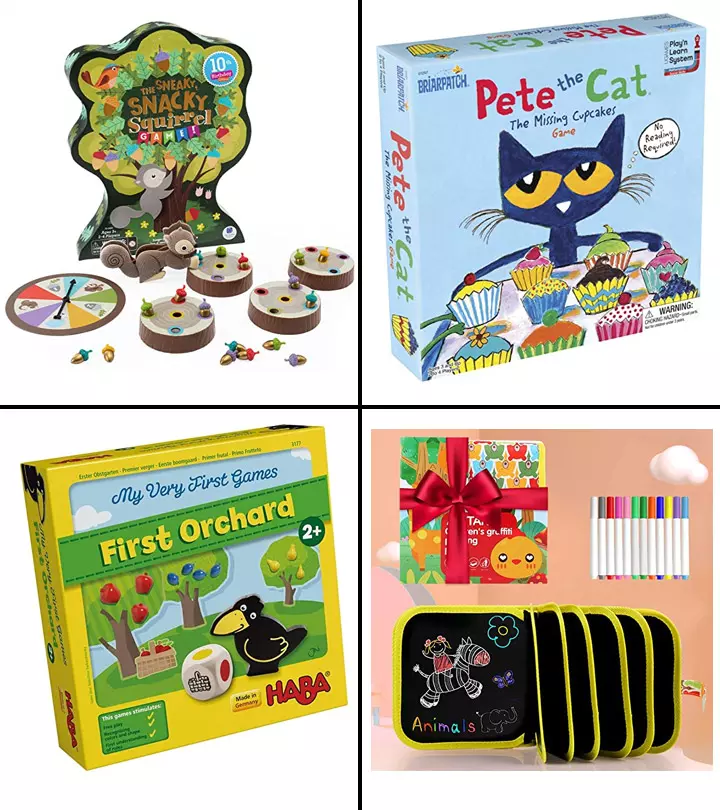
Image: MomJunction Design Team
As kids grow up, they want more stimulating toys to develop their interests. The more curious your child is, the more engaging their games need to be. So, here’s our list of the best board games for 3-year-olds to help you choose the right one. These engaging and educational board games motivate your child to learn and improve their motor, social, and cognitive skills while having fun and staying occupied. We bring you the best-selling board games in various themes and designs that you can add to your kid’s board game collection.
Top Picks
15 Best Board Games For 3-Year-Olds
1. Best Entertaining: Briarpatch Pete The Cat Missing Cupcakes Board Game
In this entertaining Pete the Cat Missing Cupcakes Board Game by Briarpatch, players gather vibrant 3D cupcakes, sing songs, perform physical activities, and identify and name their favorite creatures, foods, and words. Pete, the protagonist, and his little companions take your little one on a thrilling journey while retrieving the stolen cupcakes from Grumpy Toad. This memory and chance game is based on James and Kimberly Dean’s book Pete the Cat and the Missing Cupcakes. It can quickly become the little ones’ favorite board game as it does not involve excessive reading or complicated steps. Check out this video to learn how the classic game works.
Pros
- Vibrant colors
- Detailed illustrations
- Includes instructional manual
- Suitable for two to four players
Cons
- Spinner may be slightly flimsy
2. Best For Fine Motor Skills:Educational Insights Special Edition The Sneaky, Snacky Squirrel Game
The special edition board game from Educational Insights includes a soft fuzzy squirrel squeezer and 20 golden acorns with colorful tops. You win if you are the first to fill your log with five acorns. This set also contains four logs, one game spinner, and a tree-shaped board. It can improve your child’s sorting abilities, strategic thinking, hand-eye coordination, fine motor skills, problem-solving skills, and numerical skills. If you are looking for the best children’s games for three-year-olds, this is a suitable choice. Check out a tester’s experience in this review for a detailed understanding of the product.
Pros
- Multi-player
- Includes an instruction guide
- Durable
- Easy to hold
Cons
- May be too simple
"This game strongly appeals to my little one and his older sister. The squirrel-shaped tongs have enhanced the fun and helped them practice their motor skills. All in all, the blend of learning and fun has made it an excellent choice for introducing my little ones to board games."
3. Best For Teamwork: Wonder Forge Richard Scarry’s Busytown Eye Found It! Hidden Picture Game
The cooperative game for young children contains one game board, four movers shaped like cars, four mover bases, one spinner, one ferry tile, ten magnifying glass tokens, six food tiles, one sand timer, 30 goldbug cards, and instructions. You have to race across the 6-foot long game board to find different objects. The parent-recommended board game has well-made, durable parts and is colorful to keep the child engaged for hours. Explore this video review where the reviewer explains the game to help you understand the product better.
Also Recommended By: The experts at Happierhuman, Tinyhandstidyhome, Gamecows, Thespruce and Parentportfolio also think highly of Wonder Forge Richard Scarry’s Busytown Eye Found It! Hidden Picture Game.[1]10 Best Board Games for Toddlers [2025 Update]. Happierhuman https://www.happierhuman.com/board-games-toddlers/[2]21 BEST BOARD GAMES FOR 3 YEAR OLDS AND PRESCHOOLERS IN 2025. Tinyhandstidyhome https://tinyhandstidyhome.com/board-games-for-3-year-olds/[3]Best Board Games for 3-Year-Olds. Gamecows https://gamecows.com/best-board-games-for-3-year-olds/[4]The 12 Best Board Games for Kids of 2025. Thespruce https://www.thespruce.com/best-board-games-for-kids-4158094[5]40+ Board Games for 3 Year Olds: Learn, Play, and Have Family Fun!. Parentportfolio https://parentportfolio.com/board-games-for-3-year-olds/
Pros
- Helps develop teamwork and attention span
- Easy to play
- Encourages object-identification skills
- Multi-player
Cons
- Illustrations may be very small
"Our family loves this game—it is a blast for both the kids and us adults. I enjoy the teamwork vibe instead of spirited competition, as it creates a positive play atmosphere. The game is easy to understand, but still offers a challenge that keeps things interesting."
 Quick tip
Quick tip4. Best For Vocabulary:Skillmatics Search And Find Game
The educational search and find game by Skillmatics allows your little one to build their core skills through fun-filled learning activities. The recommended age range for this game is three to six years. Your toddler can develop vocabulary and matching skills through various themes such as the park, camp, outer space, and jungle safari-based finding activities, making it one of the best games for three-year-olds. This tried-and-tested game has six double-sided activity mats, two Skilly Billy pens, a duster cloth, and a Skilly Billy Achievement certificate to be given when your child finishes the mentioned activities.
Pros
- Easy to play
- Engaging
- Good learning outcome
- Easy to use
- Sturdy mats and pens
Cons
- Markers may not be stain-resistant
- Markers might dry up easily
"These search and find mats have proven engaging for my young children, both the restless and the focused ones. And their erasable and reusable nature is much appreciated. My children also find it fun to come up with pretend stories about the fun characters on the mat. Overall, it's been a great game for getting in some quiet time."
5. Best For Beginners:Ravensburger Snail’s Race Board Game
The Snail’s Race, from the trusted brand Ravensburger, is a fun board game for kids aged three years and above and can be played by two to six players at a time. This toddler board game for three-year-olds features six colorful garden snails that your little one could race as per the number on the rolling dice. One game can be played in nearly 15 minutes. The dimensions of the board are 19.61×8.78×0.12in, and each box contains six wooden snails, two colored dice, one playing board, and an instruction manual.
Pros
- Easy to learn and play
- Sturdy wooden pieces
- Bright colors
- Non-competitive
Cons
- Might end too quickly
- Might not be challenging enough
"This game has been a fantastic teaching tool for my kids. It helped me subtly introduce the concept of color recognition, turn-taking, and dealing with the twists of chance. Its impressive features and benefits have also encouraged me to gift this game to friends and family."
 Quick tip
Quick tip6. Best To Learn Math:Zobmondo!! The Ladybug Game
The award-winning Ladybug Game from Zobmondo!! is designed for the whole family to play together. Created by a first-grader, the players need to feed the ants, evade the praying mantis, and transport the Ladybug home safely to win. The set can quickly become your little one’s favorite board game as it includes a colorful game board, four ladybug pawns and stands, 61 aphid chips, eight praying mantis passes, and 38 ladybug cards, and the package measures 9x2x9 inches.
Pros
- Multi-player
- Helps improve memory and mathematical abilities
- Easy to learn
- No reading required
Cons
- May be difficult to clean up
"This board game has been a delightful way for my kids to learn counting and follow directions. While I had to simplify the rules for the younger ones, the endearing story, bright colors, and engaging gameplay kept them entertained. Hence, it gets my approval."
7. Best For Social Skills: Haba My Very First Games – First Orchard Cooperative Board Game
The cooperative board game from Haba requires players to roll the dice and collect the corresponding fruit from the orchard before the raven gets down the road to steal everything. It includes sixteen big wooden fruit pieces, such as four green apples, four red apples, four yellow pears, four blue plums, chunky colored die to promote color recognition, wood raven, five path cards, and four trees.
Pros
- Promotes teamwork
- Helps develop social skills
- Easy to play
- High-quality components
Cons
- May have a strong paint odor
"This board game is a fun yet educational way to get my toddlers started on board games. It encourages cooperative play and teaches turn-taking and color recognition. I am impressed with the quality of the parts and the vibrant wooden pieces."
 Did you know?
Did you know?8. Best For Concentration: Hasbro Gaming Don’t Spill The Beans Game
Suitable for children aged three and above, this fun game can be played with two players and involves bean balancing and jar tipping. Players can take turns placing their beans in a wobbly plastic jar without letting them escape. It allows your little one to develop concentration, hand-eye coordination, and motor skills through this fun, colorful game.
Pros
- Includes labels
- Helps develop memory skills
- Simple instructions
- Easy to set up
Cons
- Pieces might come apart easily
- Wobbly jar might not tip in certain positions
"My young man had a blast playing this game. The simple gameplay has also helped him learn the importance of turn-taking and sharing. Although its design could benefit from simplification for storage, it has made it survive my little one’s enthusiastic play."
9. Best For Improving Handwriting Skills: Educational Insights Pete The Cat I Love My Buttons Board Game
With the Educational Insights Pete the Cat I Love My Buttons Board Game, transform playtime into a family activity. This game is designed to make the most of shared moments and enables kids to develop various skills through play and interaction with other players. Young minds recognize shapes, colors and develop matching skills with each spin, while using the squeezer to collect misplaced buttons enhances their fine motor skills. This game lets the kids experience the fun of teamwork, compromise, sharing, and gracefully handling wins and losses.
Pros
- Includes 20 buttons and a squeezer cat
- Colorful artwork
- Builds handwriting skills
- Comes with an instruction manual
Cons
- Spinner may jam at times
"My kids are fans of Pete the Cat, so this game has them hooked. I like that it is durable and encourages turn-taking, but I wish the spinner was a bit smoother. Plus, the matching part has helped enhance their shape-recognition skills. Overall, it's a decent buy."
10. Best For Image Recognition: Skip Hop Zoo Crew Bingo
The Zoo Crew Bingo board game by Skip Hop gives a modern touch to the traditional Bingo game. This game requires little ones to match pictures on their bingo cards to the adorable characters from the zoo and say Bingo out loud. This educational game promotes the development of fine motor skills and image recognition entertainingly. It goes beyond simple amusement. According to the reviewers, the game can help enhance family time and make skill development joyous for the children.
Pros
- 78-piece set
- Easy-to-hold cards
- Thick and durable board
- Legible and colorful illustrations
Cons
- May not include a storage box
"This zoo-themed bingo game has been a hit with my kids. It teaches them image recognition skills, and they love to yell out BINGO when they win. It is a simple yet fun game for family nights. Go for it."
11. Best For Dexterity: Peaceable Kingdom Feed The Woozle Cooperative Game
In Feed The Woozle board game by Peaceable Kingdom, your little one needs to feed the monster, Woozle, 12 hairy pickles, and fuzzy donuts before the other players do. As kids join forces to help the Woozle feast, they cultivate essential skills such as dexterity, fine motor abilities, and counting. This educational game also helps foster cooperation and turn-taking and promotes valuable social skills.
Pros
- Has three difficulty levels
- Includes 24 snacks, 12 yummy cards, a die, a spinner, and a spoon
- Enhances decision-making skills
- Ideal for two to five players
Cons
- May not be suitable for older children
"I played "Feed the Woozle" with almost all the kids in my family and noticed that they all loved it. It has gotten the little ones moving, enhanced their balance, and even thrown in some giggles with its silly snack theme. Plus, the multiple levels have helped the game grow with the children."
12. Best Non-Toxic:Orchard Toys Moose Games Pizza, Pizza! Game
The fun color- and shape-matching board cum card game encourages your child to take turns and develop social skills while playing. It is suitable for two to four players and ages three to seven. The game allows players to spin both spinners and find the pizza slice card matching the color or shape of the vegetable toppings with the one shown on the spinner. The product dimensions are 1.97×10.24×8.86in.
Pros
- Game pieces are thick and sturdy
- No choking hazard
- Bright colors
- Improves visual recognition
- Easy to play
- Easy setup
Cons
- Spinner might not work well
- May not have enough topping options
"The little pizza lovers in my house were thrilled to get their hands on this game. They love that they can make both yummy and yucky pizzas with this set. The game has also helped me enhance their color and shape recognition skills. Hence, it has found a permanent spot in my home."
13. Best For Preschool Learning:Hasbro Chutes And Ladders: Peppa Pig Edition Board Game
The Hasbro Chutes and Ladders board game is a colorful climbing and sliding adventure with your child’s favorite Peppa Pig characters. This fun game is appropriate for children who haven’t started to read yet, and different numbers all around the board can help your child with their math skills and preschool learning. Made to be portable, you can carry it along for family day-outs, picnics, summer holidays, and camping.
Pros
- Includes four Peppa Pig character movers
- Helps children learn to identify numbers
- Easy to set up and play
- Engaging artwork
Cons
- Pictures may be slightly small
- May not be wear-resistant
"My Peppa Pig-obsessed grandkids love playing this themed Chutes and Ladders game. The game offers wholesome fun, and we appreciate its simple joy and humor. It might take the little ones some time to figure out the rules, but the happiness it brings is worth it."
14. Best For Concentration:Hasbro Gaming Ants In The Pants Game
Hasbro Gaming introduces a new version of the classic game Ants In The Pants. This flip-flopping game comes with 16 colorful plastic ants flying into the wide-suspended pant of the adorable panda. The game is designed to improve your child’s accuracy and concentration by aiming for the ants to get into the pant. With every win, they find it even more engaging to go on for hours.
Pros
- Easy to play
- Easy to set up
- Helps improve interactive and social skills
- No reading required
Cons
- Panda may not fit right into the pant
- Ants may be too small
"Introducing this classic game to my little one has brought me so much joy. While I am still to test its durability, the game has kept my kids away from the screen and brought them hours of entertainment. They even love to whip it out during family game nights."
15. Best For Memory:Skillmatics Memory Match Board Game
The award-winning game involves matching tiles to the picture boards while rolling a picture die and matching animals to their habitats. With this fun game, your little one will grow more observant. This strategy game allows your child to hone their spatial reasoning and memory skills while educating them about animal habitats. Suitable for children aged three to seven, this game could be played among two to five players. Each game has 34 tiles, five game boards, a wooden picture die, and an instruction manual.
Pros
- Easy to play
- Easy to set up
- Keeps the child engaged
- Improve memory
- Each card is unique
- Improve visual recognition
- Sturdy
Cons
- Might not be similar to a classic memory game
- Might have too many uncommon animals
"After playing a few rounds of this memory match game with my kids, it is clear that it is perfect for the little ones. The two play options offer variety, and while the animal groups part can be a bit tricky, it only helps them work on their skills. All in all, it's a unique memory game that doubles as an educational tool."
How To Choose The Right Board Games For 3-Year-Olds?
Here are some interesting points to consider when buying board games for three-year-olds.
- Attention span: Children may prefer playing with short, straightforward, and easy-to-grasp games. Choose games that are not complicated and provide quick outcomes.
- Interests: Consider the child’s interests when buying a board game to ensure they like it. While some children enjoy competitive games, others like puzzles, and a few like cooperative and strategy games that promote team play.
- Complexity: Choose games that are easy to learn and play at the basic level but not too simple to bore the child. They should be age-appropriate and help the child learn the necessary skills while being engaging.
- Educational benefits: Make sure the board game you choose is suitable for enhancing skill development. Look for educational games that feature activities to improve critical thinking, problem-solving skills, teamwork, communication, and more.
Frequently Asked Questions
1. Can three-year-olds play board games?
Yes, you will find board games that are thoughtfully created keeping a three-year-old’s cognitive skills in mind. They are also super entertaining and help improve interaction skills.
2. When should children be introduced to board games?
By and large, three years is an ideal age to introduce children to board games. It’s also the right age to instill patience and discipline–traits that board games can facilitate.
3. Can board games improve concentration skills?
Since board games involve comprehending and following a set of instructions while requiring one to focus on what the other players are doing, they can help improve concentration skills.
4. What does every good board game need?
A good board game for a three-year-old should be easy to follow yet interesting. It should also be colorful and made of durable materials. Further, it shouldn’t have too many small parts that could pose a choking hazard.
5. How many players should a board game have?
This depends on the type of board game being played. It could range from two to five members.
Board games are one of the most entertaining ways to bond with your family. Such games introduce your children to a whole new world of concepts. With this fantastic selection of games for children belonging to that age group, you can get the party started. Boardgames help your child improve their motor, cognitive, and social skills. While choosing the best board games for three-year-olds, opt for ones that are challenging but not overly complicated, and cater to the child’s interests. Board games provide an excellent learning opportunity with numbers, letters, colors, and patterns and help improve their language, critical thinking, and math skills.
Infographic: What Are The Benefits Of Board Games For 3-Year-Olds?
Board games are fun and engaging activities for toddlers to enjoy with their parents, caregivers, or siblings. It can also be a great educational way to help little ones develop important skills. So, this infographic presents the benefits of board games for your 3-year-old. Keep reading! Illustration: Momjunction Design Team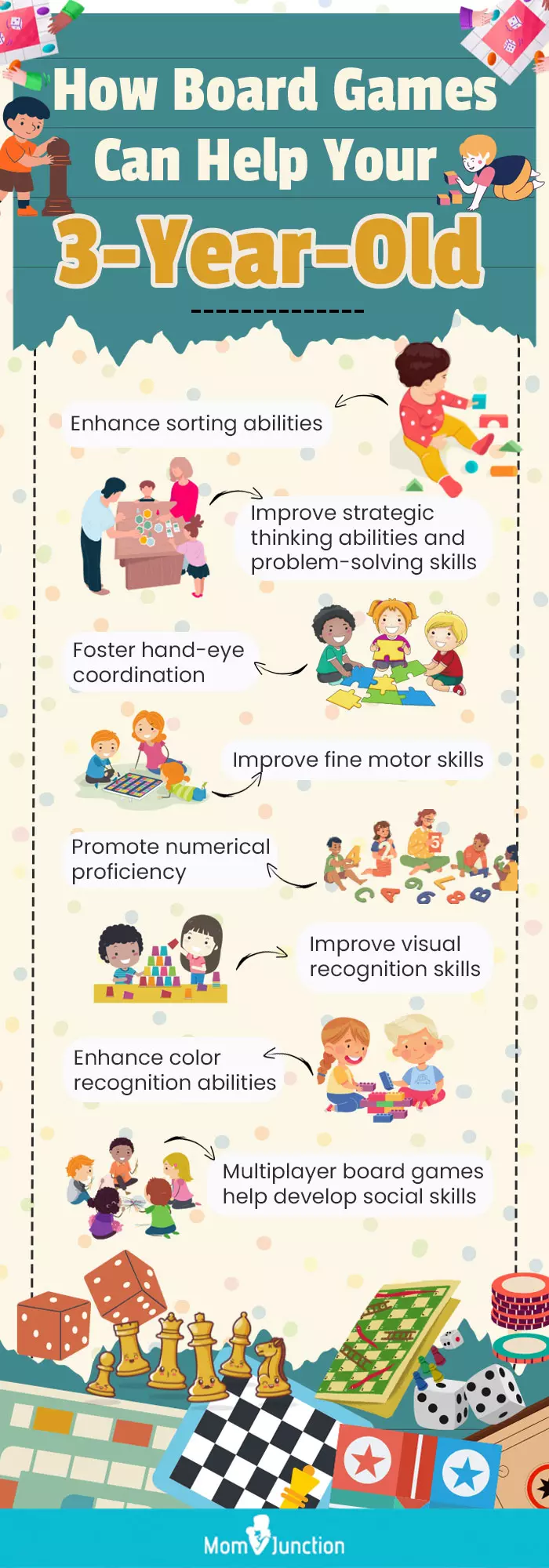
Why Trust MomJunction?
Priti Bose is a skilled product writer specializing in children’s toys and gift products. She curated the best board games for three-year-olds after extensive research through various consumer reviews and features of multiple consumer-tested products available on different websites. She even compiled pros and cons along with a buying guide, so you pick the suitable board game for your little one.
Community Experiences
Join the conversation and become a part of our nurturing community! Share your stories, experiences, and insights to connect with fellow parents.
Read full bio of Priti Bose
Read full bio of Wedetso Chirhah
Read full bio of Nisha Bharatan




